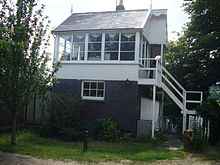Wellow, Somerset
| Wellow | |
|---|---|
Avon and Somerset | |
| Fire | Avon |
| Ambulance | South Western |
| UK Parliament | |
Wellow is a village and
History
There is a
A little further west is the
The parish gave its name to the
On 26 June 1685 the
In the 1880s and 1890s a small mine extracting and drying Fuller's earth was situated between Wellow and Stoney Littleton and also beside Hassage Hill and Bath Hill linked to the roads by short tramways.[8] The existence of Fullers Earth around Wellow has caused several collapses of local roads and has been used for forensic identification of a vehicle in a murder enquiry.
In World War II the Wellow valley became part of the GHQ stop line green, with defences intended to isolate southern England in the event of German invasion. The remains of a number of type 24 pillboxes and anti-tank cubes can be found in various riverside locations both upstream and downstream of the village.

Governance
The

The parish falls within the
Between 1974 and 1996 Bath and North East Somerset carried out district council functions only, county council services being provided by Avon County Council. Before 1974 the parish was part of the Bathavon Rural District of Somerset.[9]
The parish falls within the constituency of
Geography

Nearby are the Hinton Hill and Cleaves Wood sites of Special Scientific Interest.
.Hinton Hill is of importance to studies of the stratigraphy of the Middle Jurassic of the Bath district, and the British Bathonian as a whole.[10]
Religious sites

The parish
References
- ^ a b "Wellow Parish". Neighbourhood Statistics. Office for National Statistics. Retrieved 31 December 2013.
- ^ "Wellow Conservation Area Character Appraisal". Bath and North East Somerset Council. Archived from the original on 21 October 2007. Retrieved 14 January 2008.
- ^ "Packhorse Bridge over Wellow Brook". historicengland.org.uk. Retrieved 8 October 2006.
- ISBN 1-902007-01-8.
- ^ "Stoney Littleton Long Barrow". Scheduled Monument Record. Bath and North East Somerset. Archived from the original on 18 September 2010. Retrieved 3 October 2010.
- ^ "Stoney Littleton". Stones of England. Retrieved 15 March 2008.
- ^ "Somerset Hundreds". GENUKI. Retrieved 22 October 2011.
- ISBN 978-1-899889-32-7.
- ^ "Bathavon RD". A vision of Britain Through Time. University of Portsmouth. Retrieved 4 January 2014.
- ^ English Nature citation sheet . Retrieved 12 July 2006.
- ^ a b English Nature citation sheet for the site. Retrieved 16 July 2006.
- ISBN 1-874357-18-8page 252
- ISBN 1-874357-18-8page 247
- ^ "Parish Church of St Julian, Wellow". historicengland.org.uk. Retrieved 8 October 2006.
External links
- "Area 12 Cam and Wellow Brook Valleys". BANES Rural Landscapes. Retrieved 3 October 2010.
- Wellow Conservation Area Character Appraisal
